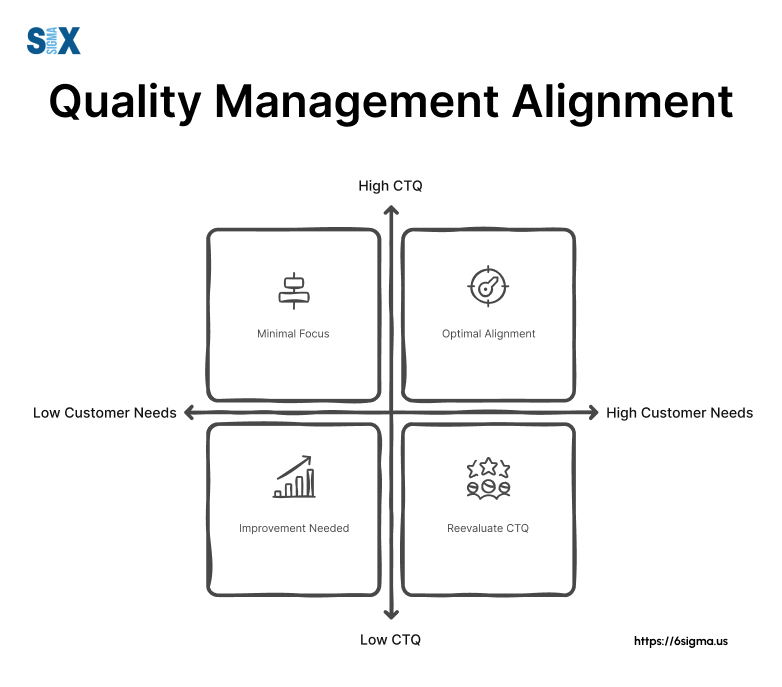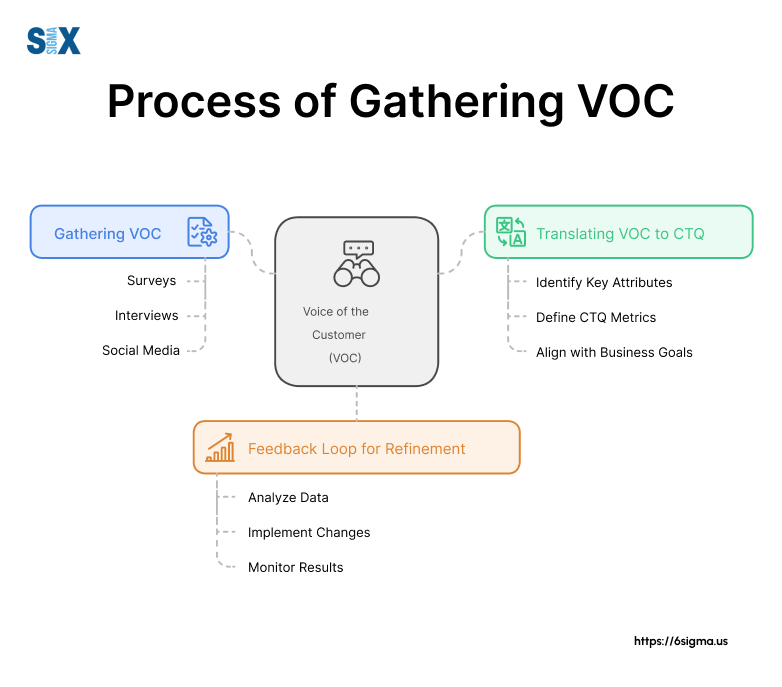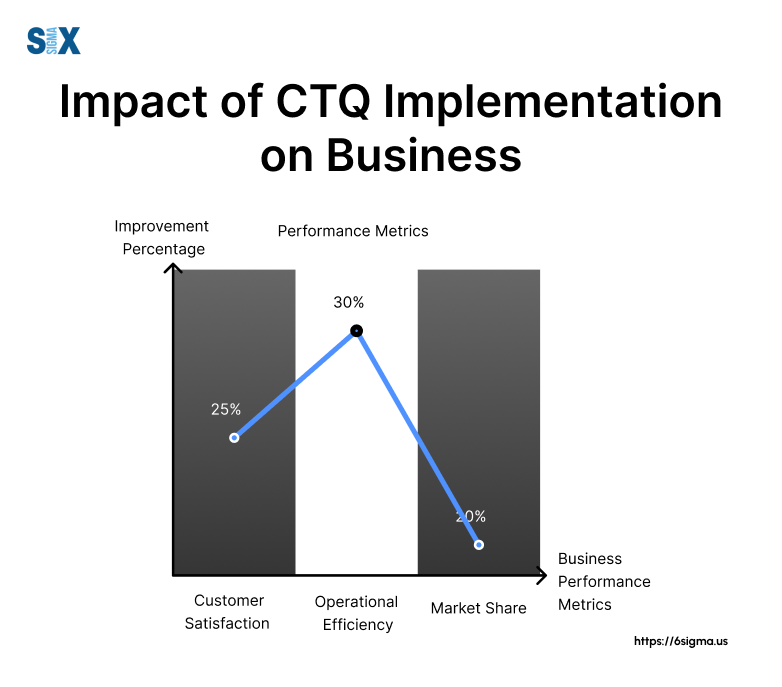Critical to Quality (CTQ) is a fundamental concept in quality management that focuses on identifying and meeting customer needs to drive business success.
Understanding and implementing CTQ is essential for organizations aiming to deliver superior products and services.
Pinpoint what truly matters to your customers
Transform customer needs into measurable improvements with our Lean Six Sigma Green Belt Certification.

This powerful tool, rooted in Six Sigma methodology, enables companies to translate customer requirements into measurable performance metrics, ensuring that every aspect of their operations aligns with customer expectations.
Key Highlights
- CTQ definition and its role in Six Sigma
- Voice of the Customer integration with CTQ
- Creating and implementing CTQ trees
- CTQ’s impact on process improvement and DMAIC
- Business benefits of CTQ implementation
- Future trends in CTQ and data-driven decision making
Understanding Critical to Quality (CTQ)
Critical to Quality (CTQ) is a cornerstone of modern quality management practices.
Let’s learn its definition, importance, and role in driving business excellence.
Definition and Importance
Critical to Quality (CTQ) refers to the key measurable characteristics of a product or service that are essential to customer satisfaction.
These characteristics are directly tied to customer needs and expectations, making them crucial for business success.
CTQ is important because it helps organizations focus on what truly matters to their customers, ensuring that resources are allocated efficiently to meet and exceed customer expectations.
Critical to Quality (CTQ) in the Context of Six Sigma Methodology
In Six Sigma methodology, CTQ plays a pivotal role. Six Sigma, a data-driven approach to process improvement, utilizes CTQ to identify and prioritize areas for enhancement.
By incorporating CTQ into the Six Sigma framework, professionals with a Six Sigma certification can align quality improvement efforts with customer requirements, leading to more targeted process optimizations.

The Role of Critical to Quality in Quality Management
CTQ serves as a bridge between customer expectations and operational metrics in quality management.
It enables organizations to translate often subjective customer needs into objective, measurable criteria.
This translation is crucial for developing products and services that consistently meet or exceed customer expectations, thereby driving customer satisfaction and loyalty.
Learn the basic concepts and importance of Critical in Quality with Lean Six Sigma Yellow Belt
The Voice of the Customer (VOC) and Critical to Quality
The Voice of the Customer (VOC) is intrinsically linked to Critical to Quality. Understanding this connection is vital for organizations aiming to truly meet customer needs.
Identifying Customer Needs and Expectations
Identifying customer needs and expectations is the first step in the Critical to Quality process.
This involves gathering data through various methods such as surveys, interviews, focus groups, and customer feedback analysis.
The goal is to gain a comprehensive understanding of what customers value and expect from a product or service.
Translating VOC into Measurable Characteristics with Critical to Quality (CTQ)
Once customer needs are identified, the next crucial step is translating these often qualitative inputs into measurable characteristics.
This translation process involves breaking down broad customer requirements into specific, quantifiable attributes that can be measured and improved upon.
For example, a customer’s desire for “fast service” might be translated into a measurable CTQ like “order fulfillment time under 24 hours“.
Using Customer Feedback to Refine Critical to Quality (CTQ)
CTQ is not a static concept; it evolves with changing customer preferences and market conditions.
Continuous customer feedback is essential for refining and updating CTQ metrics.
This ongoing process ensures that organizations remain aligned with customer expectations and can adapt their quality management strategies accordingly.

Implementing Critical to Quality
Implementing CTQ requires a structured approach. This section outlines the key steps and tools used in CTQ implementation.
Creating a CTQ Tree
A CTQ tree is a visual tool that helps organizations break down customer needs into specific, measurable requirements.
1. Steps to Develop a CTQ Flowdown
Developing a CTQ flowdown involves several steps:
- Identify the primary customer need
- Break down this need into more specific requirements
- Continue breaking down until you reach measurable attributes
- Validate the flowdown with stakeholders
2. Identifying Quality Drivers and Attributes
Quality drivers are the key factors that influence customer satisfaction.
Identifying these drivers and their associated attributes is crucial for creating an effective CTQ tree.
This process often involves cross-functional collaboration and in-depth analysis of customer feedback and market trends.
Setting Performance Requirements and Targets
Once quality drivers and attributes are identified, the next step is setting clear performance requirements and targets.
These targets should be SMART (Specific, Measurable, Achievable, Relevant, and Time-bound) to ensure they can effectively guide quality improvement efforts.
Integrating Critical to Quality (CTQ) with Quality Function Deployment (QFD)
Quality Function Deployment (QFD) is a method used to translate customer requirements into specific product or service features.
Integrating CTQ with QFD provides a powerful framework for aligning product development with customer needs, ensuring that every aspect of the product or service is designed with customer satisfaction in mind.
Need a hand in implementation? Here is your detailed explanation of CTQ implementation with Lean Six Sigma Green Belt
Critical to Quality (CTQ) and Process Improvement
CTQ is a driving force in process improvement initiatives. It provides a clear focus for enhancement efforts and helps measure their success.
The DMAIC Process and Critical to Quality (CTQ)
The DMAIC process, a core component of Six Sigma, is often mastered through Six Sigma Green Belt Certification or Black Belt Certification, which equips professionals to leverage CTQ metrics at every phase of improvement.
CTQ plays a crucial role in each phase of DMAIC:
- Define: CTQ helps identify what’s important to the customer
- Measure: CTQ provides metrics for measuring current performance
- Analyze: Root cause analysis training ensures teams can systematically address issues affecting CTQ metrics.
- Improve: CTQ directs improvement efforts towards what matters most to customers
- Control: CTQ helps in monitoring and maintaining improvements
Using CTQ for Continuous Improvement
CTQ is not just a one-time exercise but a tool for continuous improvement.
By regularly revisiting and updating CTQ metrics, organizations can ensure their processes and products evolve with changing customer needs and market conditions.
Measuring Success: Key Performance Indicators (KPIs) and Quality Metrics
CTQ directly informs the development of Key Performance Indicators (KPIs) and quality metrics.
These measurements provide tangible evidence of improvement and help organizations track their progress in meeting customer needs.
Effective KPIs derived from CTQ should be directly linked to customer satisfaction and business performance.
Learn the CTQ’s role in process improvement and DMAIC with Lean Six Sigma Black Belt
Critical to Quality’s Impact on Business Performance
Implementing CTQ can have a significant positive impact on various aspects of business performance.
Let’s explore these benefits in detail.
Enhancing Customer Satisfaction and Loyalty
Organizations that train teams through Six Sigma certification programs often see faster adoption of CTQ principles, directly translating to higher customer satisfaction.”
This laser focus on customer needs leads to higher customer satisfaction levels and, consequently, increased customer loyalty.
Satisfied customers are more likely to become repeat customers and brand advocates, driving long-term business success.
Improving Operational Efficiency with Critical to Quality
CTQ helps streamline operations by identifying and prioritizing the most critical aspects of a product or service.
This focus allows organizations to allocate resources more efficiently, reducing waste and improving overall operational efficiency.
By concentrating on what truly matters to customers, companies can avoid expending resources on features or processes that don’t add significant value.
Gaining a Competitive Advantage Through Quality
Quality can be a significant differentiator.
By consistently delivering on CTQ metrics, organizations can position themselves as quality leaders in their industry.
This quality-based competitive advantage can lead to increased market share, higher profit margins, and stronger brand reputation.

The Future of CTQ in Quality Management
As we look to the future, CTQ continues to evolve and adapt.
Its role in quality management remains crucial, with new trends and technologies shaping its implementation.
Evolving Trends in CTQ (Critical to Quality) Implementation
The future of CTQ implementation is likely to be influenced by emerging technologies and changing customer expectations.
We can expect to see more real-time CTQ monitoring, enabled by IoT devices and advanced analytics.
Additionally, there may be a greater emphasis on sustainability and ethical considerations in CTQ metrics, reflecting growing consumer awareness in these areas.
The Role of Data-Driven Decision Making in CTQ
Data-driven decision making will play an increasingly important role in CTQ implementation.
As organizations gain access to more sophisticated data collection and analysis tools, they will be able to make more informed decisions about which CTQ metrics to prioritize and how to meet them effectively.
This data-centric approach will lead to more precise and impactful quality management strategies.
CTQ as a Cornerstone of Customer-Centric Organizations
In the future, CTQ will continue to be a cornerstone of customer-centric organizations.
As businesses increasingly recognize the importance of putting the customer at the center of their operations, CTQ will serve as a crucial tool for translating customer needs into actionable business strategies.
Organizations that excel in implementing CTQ will be well-positioned to thrive in an increasingly competitive and customer-driven marketplace.
In conclusion, Critical to Quality remains a powerful and essential concept in quality management.
By focusing on what truly matters to customers and continuously refining their approach based on data and feedback, organizations can use CTQ to drive sustainable success and maintain a competitive edge in their industries.






